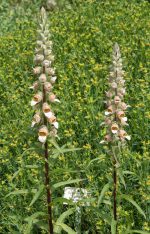 Also called wooly foxglove, this herbaceous biennial or short lived perennial is a member of the plantain family, Plantaginaceae, that also includes turtlehead, snapdragon, and Veronica. It is native to southeastern Europe where it grows in woods and scrub and was introduced to the US as an ornamental and medicinal plant but is now considered invasive in some places. During the first year plants form a basal rosette of gray-green lanceolate to oval leaves that are sessile, up to 6′ long , and have entire margins. In June or July of the second year an unbranched purple-tinged flowering stem appears carrying leaves and densely packed very pale yellow flowers with purplish netting. The tubular flowers are 1″ long and their middle lobe is longer than the other lobes and curls down. Flowers, stems, and the undersides of leaves are hairy. Although the flowers are not especially showy the plants are attractive in wildflower gardens. The genus name, Digitalis, comes from the Latin word digitus meaning finger and refers to the appearance of the flowers. The specific epithet, lanata, comes from the Latin word lana meaning wool and refers to the hairs on many parts of the plant.
Also called wooly foxglove, this herbaceous biennial or short lived perennial is a member of the plantain family, Plantaginaceae, that also includes turtlehead, snapdragon, and Veronica. It is native to southeastern Europe where it grows in woods and scrub and was introduced to the US as an ornamental and medicinal plant but is now considered invasive in some places. During the first year plants form a basal rosette of gray-green lanceolate to oval leaves that are sessile, up to 6′ long , and have entire margins. In June or July of the second year an unbranched purple-tinged flowering stem appears carrying leaves and densely packed very pale yellow flowers with purplish netting. The tubular flowers are 1″ long and their middle lobe is longer than the other lobes and curls down. Flowers, stems, and the undersides of leaves are hairy. Although the flowers are not especially showy the plants are attractive in wildflower gardens. The genus name, Digitalis, comes from the Latin word digitus meaning finger and refers to the appearance of the flowers. The specific epithet, lanata, comes from the Latin word lana meaning wool and refers to the hairs on many parts of the plant.
Type: Herbaceous biennial or short-lived perennial
Bloom: Densely packed spikes of pale yellow flowers with purplish netting and relatively long middle lobe that curls downward; in summer
Size: 2-3′ H x 1′ W
Light:Part shade
Soil: Fertile, consistently moist, well-drained
Hardiness: Zones 4-7
Care: Low maintenance
Pests and Diseases: Non of significance
Propagation: Seed
Companion Plants:Ferns, hosta,
Photo Credit: Michael Wolf ,Wikimedia Commons